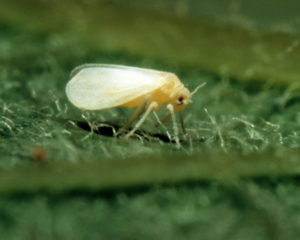By Robert Lewis
Special to the PRESS
Well it’s a good news / bad news report this week.
The good news is that with the drier weather of the last few weeks some of the crops that we notice along our highways that have been so waterlogged with frequent heavy rains have started to dry out. In the case of the cotton crops, it looks as if some may grow to maturity and produce some cotton this year.

A Sweet potato whitefly (also known as the Silverleaf whitefly) is a serious agricultural pest and is considered an invasive species. The whitefly feeds on agricultural crops such as tomatoes, squash, broccoli, cauliflower, cabbage, melons, cotton, carrots, sweet potato, cucumber, and pumpkin, and ornamental plants such as poinsettia, crepe myrtle, garden roses, lantana, and lilies. The whitefly was first found in the United States in poinsettia crops in Florida during the mid-1980s. It was found to have moved to tomatoes, other fruit and vegetable crops less than a year later and within five years had caused over $100 million in damage to the Texas and California agriculture industries.
The bad news is that every year when cotton is harvested there is a launching of the whitefly insect throughout the region, and the displaced whitefly very quickly searches for new plants to call home, and more likely your young fall garden vegetable plants will probably be invaded by these problematic little creatures. Whitefly insects love the conditions of the cotton field plants. The cotton plants are planted closely and their healthy green leaves make fine feeding for whitefly. They like areas where the winds are blocked somewhat and for them that makes for a fine feeding area. They feed on the underside of leaves which makes them more difficult to notice and also makes them much more difficult to apply insect controls.
Whiteflies can be a damaging insect for home gardeners. They suck the sap from plants and as they do they secrete a sticky substance that is referred to as “honeydew.” That honeydew secretion then forms a black mold on the leaves which is called “sooty mold,” and that area can become so thick that the leaf can become totally black which then blocks the sunlight and reduces the process of photosynthesis. The honeydew secretion and the resulting black sooty mold is not the worst of the problem.
The whitefly while sucking the leaves of the plant are injecting saliva into the plants they are feeding on and usually that creates the introduction of viruses into the plant. This is a very big problem for homeowners that have new seed plantings of tomatoes, okra, and eggplant just to name a few. Several years ago in the Rio Grande Valley our normally easy to grow fall season tomato plants started getting a yellowing and curling of the top new growth which severely stunted these plants. If the plant didn’t die they were useless and non-productive. We soon learned it was all caused by whitefly. So with our fall gardens just starting, please make sure to check your plants daily to catch the whitely from “setting up shop” in your fall garden.
This sets up another good luck/bad luck situation and this time starting with the bad luck. The bad luck is that whiteflies are hard to notice since they attack the underside of the leaves of plants. That also makes it more difficult to spray insect control to the underside of your plants foliage.
Now the good news: luckily whitefly is not a hard insect to kill. Most insecticides will list whitefly on the “list of insects controlled” label on the container. Insecticidal soap sprays work very well. Neem Oil sprays are what I like to use because they leave an oily residue after applying. Plus it will help to kill any fungus that may result from any “sooty mold” that you might have on the leaves. Almost any insect control (natural or chemical) will control whitefly, but what is important is to apply with the frequency that your product suggests in order to prevent eggs from quickly hatching and even more whitefly choosing your plant to latch on to. With Neem Oil I like to apply twice a week. Many gardeners will try to use a systemic insecticide at the seedling stage to try to beat them that way, but on vegetable plants I choose to keep it natural. I just feel better when I’m eating my homegrown vegetables and I don’t have to worry about what has been used on them in past months to control insects.
Now that we are in the middle of August, the best thing that you can do for all of your plants is to visit them daily and to touch them with your hand or a stick. Any slight rustling or shaking of the plant will dislodge them and you will see them flying around quickly and then settling back on to the plant, if you see that then it’s time to spray. I like to spray the underside of the leaves starting from the bottom up and then lightly on the top of the foliage. Whitefly control in your home garden is not difficult to control. Just stay on top of the situation and react quickly when you see you have them.
FALL VEGETABLE GARDEN NOTICE: If you did not plant seeds for your vegetables back in July, it is important to watch the nurseries for the arrival of tomato plants and other vegetables as the time for planting them is mid-August through mid-September.
Until next week.
Editor’s note: Robert Lewis is owner and operator of R. Lewis Landscaping in Port Isabel.


1 pings
[…] Source link […]